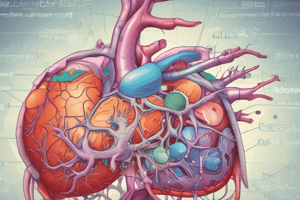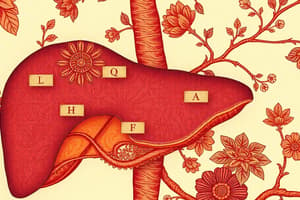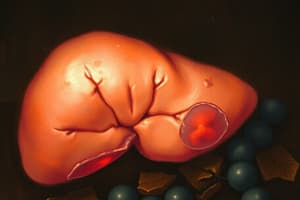Podcast
Questions and Answers
During periods of fasting or starvation, what is the primary source of amino acids used by the liver for gluconeogenesis?
During periods of fasting or starvation, what is the primary source of amino acids used by the liver for gluconeogenesis?
- Liver protein breakdown
- Muscle protein breakdown (correct)
- Dietary protein
- Fatty acid breakdown
Which of the following statements accurately describes the role of very low-density lipoproteins (VLDLs)?
Which of the following statements accurately describes the role of very low-density lipoproteins (VLDLs)?
- VLDLs are produced by the liver to transport cholesterol from peripheral tissues to the liver.
- VLDLs are produced by the liver to transport triglycerides from the liver to other tissues. (correct)
- VLDLs are primarily involved in the synthesis of ketones from fatty acids.
- VLDLs are responsible for scavenging cholesterol from the blood and peripheral tissues.
What is the primary function of high-density lipoproteins (HDLs)?
What is the primary function of high-density lipoproteins (HDLs)?
- Providing a circulating reservoir of apoproteins for activating chylomicrons.
- Scavenging cholesterol from the blood and peripheral tissues. (correct)
- Transporting triglycerides from the liver to other tissues.
- Synthesizing ketones from fatty acids.
Which of the following is NOT a ketone body produced by the liver?
Which of the following is NOT a ketone body produced by the liver?
Why are ketone bodies important during periods of fasting or starvation?
Why are ketone bodies important during periods of fasting or starvation?
Which of the following is the primary site of glycogen storage in the body?
Which of the following is the primary site of glycogen storage in the body?
What is the significance of the liver's ability to synthesize non-essential amino acids?
What is the significance of the liver's ability to synthesize non-essential amino acids?
What is the main reason why fatty acids are not readily used as a fuel source by the brain?
What is the main reason why fatty acids are not readily used as a fuel source by the brain?
What is the primary role of glucokinase in hepatocytes?
What is the primary role of glucokinase in hepatocytes?
Which plasma proteins are NOT primarily synthesized by hepatocytes?
Which plasma proteins are NOT primarily synthesized by hepatocytes?
What process directly links the liver's role in gluconeogenesis with its primary function in urea production?
What process directly links the liver's role in gluconeogenesis with its primary function in urea production?
Which metabolic process is MOST closely linked to the liver's ability to maintain nutrient homeostasis during fasting?
Which metabolic process is MOST closely linked to the liver's ability to maintain nutrient homeostasis during fasting?
A deficiency in Vitamin K would most likely lead to which of the following?
A deficiency in Vitamin K would most likely lead to which of the following?
How does albumin contribute to maintaining the osmolality of the plasma?
How does albumin contribute to maintaining the osmolality of the plasma?
Which scenario is most likely to lead to increased risk of edema formation?
Which scenario is most likely to lead to increased risk of edema formation?
What is the primary function of triglycerides stored in the liver?
What is the primary function of triglycerides stored in the liver?
Which of the following statements accurately describes the role of bile salts in fat digestion?
Which of the following statements accurately describes the role of bile salts in fat digestion?
Which of the following components is NOT directly involved in the process of bilirubin excretion?
Which of the following components is NOT directly involved in the process of bilirubin excretion?
Which of the following is a key function of Phase I reactions in drug metabolism?
Which of the following is a key function of Phase I reactions in drug metabolism?
Which of the following pairs represents a drug that becomes MORE active after undergoing liver metabolism?
Which of the following pairs represents a drug that becomes MORE active after undergoing liver metabolism?
Which of the following best describes how bile salts facilitate fat digestion?
Which of the following best describes how bile salts facilitate fat digestion?
Which of the following is NOT a common compound involved in Phase II reactions of drug metabolism?
Which of the following is NOT a common compound involved in Phase II reactions of drug metabolism?
Based on the information provided, which of the following statements is TRUE regarding the metabolism of steroid hormones in the liver?
Based on the information provided, which of the following statements is TRUE regarding the metabolism of steroid hormones in the liver?
Which of the following best describes the relationship between bile salts and micelle formation?
Which of the following best describes the relationship between bile salts and micelle formation?
What is the primary mechanism by which the liver prevents a vitamin A deficiency for an extended period?
What is the primary mechanism by which the liver prevents a vitamin A deficiency for an extended period?
Which of the following is NOT a direct function of the liver in relation to iron metabolism?
Which of the following is NOT a direct function of the liver in relation to iron metabolism?
How does the liver contribute to the regulation of blood glucose levels?
How does the liver contribute to the regulation of blood glucose levels?
What is the primary consequence of frequent drug administration on cytochrome P-450 activity?
What is the primary consequence of frequent drug administration on cytochrome P-450 activity?
What is the primary reason why drugs administered orally may undergo "first-pass metabolism"?
What is the primary reason why drugs administered orally may undergo "first-pass metabolism"?
How do somatomedins, also known as Insulin-Like Growth Factors (IGFs), contribute to growth and development?
How do somatomedins, also known as Insulin-Like Growth Factors (IGFs), contribute to growth and development?
How does the liver contribute to the removal of intestinal bacteria from the circulatory system?
How does the liver contribute to the removal of intestinal bacteria from the circulatory system?
In the context of first-pass metabolism, why might certain medications be administered intravenously rather than orally?
In the context of first-pass metabolism, why might certain medications be administered intravenously rather than orally?
Which of the following statements accurately describes the role of the liver in carbohydrate metabolism during periods of fasting?
Which of the following statements accurately describes the role of the liver in carbohydrate metabolism during periods of fasting?
What is the primary function of VLDLs (very low-density lipoproteins) in the context of liver function?
What is the primary function of VLDLs (very low-density lipoproteins) in the context of liver function?
How does the liver contribute to the maintenance of blood glucose levels during prolonged fasting?
How does the liver contribute to the maintenance of blood glucose levels during prolonged fasting?
Which two processes are primarily involved in the liver's role in maintaining blood glucose levels during periods of fasting?
Which two processes are primarily involved in the liver's role in maintaining blood glucose levels during periods of fasting?
The liver plays a crucial role in the metabolism of dietary sugars. Which of the following dietary sugars is primarily utilized by the liver for energy or conversion into glucose?
The liver plays a crucial role in the metabolism of dietary sugars. Which of the following dietary sugars is primarily utilized by the liver for energy or conversion into glucose?
What is the primary role of gluconeogenesis in the liver during periods of fasting?
What is the primary role of gluconeogenesis in the liver during periods of fasting?
Which of the following is NOT a carbohydrate metabolic process directly involved in the liver's regulation of blood glucose levels?
Which of the following is NOT a carbohydrate metabolic process directly involved in the liver's regulation of blood glucose levels?
Which statement best explains the liver's central role in regulating blood nutrient levels?
Which statement best explains the liver's central role in regulating blood nutrient levels?
Flashcards
Liver Functions
Liver Functions
Diverse roles of the liver essential for health.
Maintain Homeostasis
Maintain Homeostasis
Regulation of blood nutrients and glucose supply.
Glycogen
Glycogen
Storage form of glucose in the liver.
Glycogenolysis
Glycogenolysis
Signup and view all the flashcards
Gluconeogenesis
Gluconeogenesis
Signup and view all the flashcards
Ketones
Ketones
Signup and view all the flashcards
Plasma Proteins
Plasma Proteins
Signup and view all the flashcards
Detoxification
Detoxification
Signup and view all the flashcards
Glycogen Storage
Glycogen Storage
Signup and view all the flashcards
Hepatocytes
Hepatocytes
Signup and view all the flashcards
VLDL
VLDL
Signup and view all the flashcards
HDL
HDL
Signup and view all the flashcards
Amino Acids
Amino Acids
Signup and view all the flashcards
Non-essential Amino Acids
Non-essential Amino Acids
Signup and view all the flashcards
Bile Salts
Bile Salts
Signup and view all the flashcards
Micelles
Micelles
Signup and view all the flashcards
Bilirubin
Bilirubin
Signup and view all the flashcards
Heme Catabolism
Heme Catabolism
Signup and view all the flashcards
Phase I Reactions
Phase I Reactions
Signup and view all the flashcards
Cytochrome P-450
Cytochrome P-450
Signup and view all the flashcards
Phase II Reactions
Phase II Reactions
Signup and view all the flashcards
Conjugation
Conjugation
Signup and view all the flashcards
Urea
Urea
Signup and view all the flashcards
Glucokinase
Glucokinase
Signup and view all the flashcards
Cholesterol Synthesis
Cholesterol Synthesis
Signup and view all the flashcards
Clotting Factors
Clotting Factors
Signup and view all the flashcards
Albumin
Albumin
Signup and view all the flashcards
Vitamin K
Vitamin K
Signup and view all the flashcards
Edema Formation
Edema Formation
Signup and view all the flashcards
First-pass metabolism
First-pass metabolism
Signup and view all the flashcards
Vitamin Storage in Liver
Vitamin Storage in Liver
Signup and view all the flashcards
Ferritin
Ferritin
Signup and view all the flashcards
Somatomedins
Somatomedins
Signup and view all the flashcards
Kupffer cells
Kupffer cells
Signup and view all the flashcards
Chondrocytes
Chondrocytes
Signup and view all the flashcards
Osteoblasts
Osteoblasts
Signup and view all the flashcards
Study Notes
Liver Functions
- The liver plays a crucial role in maintaining overall health and life, fulfilling a broad range of functions.
- Maintaining homeostasis of nutrients: The liver regulates blood nutrients, ensuring a consistent glucose supply for neurons and distributing fatty acids as ketones or triglycerides in very low-density lipoproteins (VLDLs).
- Carbohydrates: The liver stores glucose as glycogen and releases it during needed times (glycogenolysis) and synthesizes glucose (gluconeogenesis) from other sources.
- Glycogenolysis: Breaks down glycogen to provide glucose during times of fasting (low blood sugar) to maintain blood glucose levels and keep neurons functioning.
- Gluconeogenesis: The liver converts, certain other substances like amino acids and glycerol, into glucose. This glucose is essential for neurons during periods of fasting.
- Lipids: The liver synthesizes and releases various lipoproteins, including very low-density lipoproteins (VLDLs) for fatty acid distribution, high-density lipoproteins (HDLs) for cholesterol scavenging, and produces ketones (water-soluble fatty acid analogs) from fatty acids during times of fasting.
- Amino Acids: The liver uses amino acids from skeletal muscle during periods of fasting for gluconeogenesis. The liver also synthesizes non-essential amino acids.
- Storing Nutrients: The liver stores glycogen and lipids. Glycogen is crucial for sustaining blood glucose during fasting periods; lipids (triglycerides) are also stored, though diseases can lead to excessive accumulation.
- Synthesizing and Releasing Plasma Proteins: The liver synthesizes many plasma proteins, critically including clotting factors and albumin. Albumin is vital for fluid balance in the body, and clotting factors are essential for blood clotting.
- Synthesizing and Releasing Bile: The liver produces bile, containing bile salts/acids that are crucial for emulsifying dietary fats and increasing their surface area for efficient digestion. Bile also contains bilirubin and cholesterol
- Processing and Excreting Bilirubin: Bilirubin, a waste product of heme breakdown, is processed and excreted in bile by the liver; this process involves conjugation with glucuronic acid.
- Detoxification and Excretion: The liver neutralizes harmful substances, such as drugs, hormones, and toxins to prevent harm to the body and facilitates their excretion.
- Storage of Vitamins: The liver stores vitamins A, D, and B12 for use by the body, preventing deficiencies for several months.
- Iron Storage: The liver stores iron (bound to apoferritin), ensuring the body has a reserve of iron for essential processes like紅血球synthesizing.
- Synthesizing and Releasing Somatomedins: The liver produces somatomedins/ Insulin-Like Growth Factors (IGFs) that work with Growth Hormone (GH) to influence various bodily functions.
- Blood Cleansing: The liver filters blood and removes bacteria that can cause infection. Kupffer cells within the liver remove bacteria.
Studying That Suits You
Use AI to generate personalized quizzes and flashcards to suit your learning preferences.




